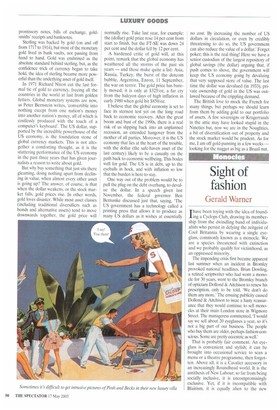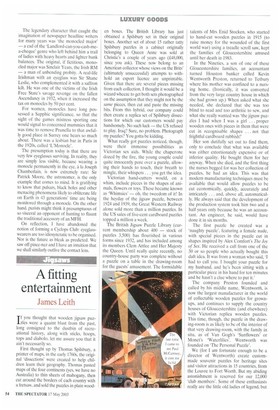Sight of fashion
Gerald Warner
Ihave been toying with the idea of foundling a Cyclops Club, drawing its membership from the dwindling band of individualists who persist in defying the zeitgeist of Cool Britannia by wearing a single eyeglass, commonly known as a monocle. We are a species threatened with extinction and we probably qualify for victimhood, as an oppressed minority.
The impending crisis first became apparent last summer when an incident in Bromley provoked national headlines. Brian Dowling, a retired scriptwriter who had worn a monocle for 30 years, went to the Bromley branch of opticians Dollond & Aitchison to renew his prescription, only to be told, 'We don't do them any more.' The ensuing publicity caused Dollond & Aitchison to issue a hasty reassurance that they would continue to sell monocles at their main London store in Wigmore Street. The manageress commented, 'I would say we sell about 20 eyeglasses a year, so it's not a big part of our business. The people who buy them are older, perhaps fashion-conscious. Some are pretty eccentric as well.'
That is probably fair comment. An eyeglass is convenient and stylish; it can be brought into occasional service to scan a menu or a theatre programme, then forgotten. Above all, it is a Cavalier accessory in an increasingly Roundhead world. It is the antithesis of New Labour; so far from being socially inclusive, it is uncompromisingly exclusive. Yet, if it is incompatible with Blairism, it is equally alien to the new Tories. The last eminent Tory to sport an eyeglass was Sir Angus Maude; with the party now firmly under the kitten-heel of Theresa May, it is unthinkable that such reactionary eye-wear would ever be permitted on the conference platform.
The social nuance between the terms 'eyeglass' and 'monocle' should briefly be noted. Although Nancy Mitford declared ex cathedra that 'spectacles' is U and 'glasses' non-U, with an inconsistency typical of the arcana of class, 'eyeglass' is strictly U, but 'monocle' generally non-U, with marginally permissible U-usage. The terms are used here indiscriminately, to avoid monotony. In everyday speech, if the topic arises, I find it convenient to refer simply to 'my lens' — a clinicalsounding, neutral terminology.
Historically, it is often claimed that Nero was the first individual to use a single eyeglass. In fact, he watched gladiatorial games through an emerald, to reduce the sun's glare, making him a pioneer of sunglasses rather than the monocle. The single lens first emerged in the 18th century, in the form of the quizzing-glass, a halflorgnette with a handle. This was employed by foppish exquisites to stare others out of countenance or to administer the social 'cut', at a time when myopia was fashionable among the ruling class.
The modem style of monocle, inserted into the eye-socket, was introduced in England in 1806, when it was known as an 'eye ring'. The invention next caught on in Vienna, where a later became an indispensable accessory in the operettas of Franz Lehar. By the late 19th century, the single eyeglass was established across Europe as a symbol of the dandy, the aristocrat or, in Germany, the militarist. The Emperor Franz Josef once refused to promote a general because he wore a monocle, which he considered a strutting, Prussian affectation. The Emperor himself wore pince-nez with his customary costume of a field-marshal's uniform.
Different styles of monocle carry moral nuances. A rimmed eyeglass with cord attached is generally worn by an Englishman, who may be playing the silly ass but is actually a formidable man of action. A rimless monocle is more sinister and is likely to be worn by a Teutonic villain. The traditional English version is rimmed, with a 'gallery' — two extensions of the rim designed to fit into the upper and lower eye-socket, making the lens stand out to avoid friction with the eyelashes. A high-tech innovation is the 'sprung gallery', which adjusts to fit the eye and may one day become respectable. Recently I have detected a deplorably macho tendency among acquaintances who wear the rimless lens to adopt the patronising view that 'real men don't wear a gallery'. One treats such Junker posturing with disdain.
An eyeglass worn on a broad ribbon is Gallic and, therefore, degenerate. Marcel Proust acknowledged this in A la recherche, when he described how the monocle of M. de Saint-Cande caused him to be 'preferred to the most handsome looks in the world by snobbish and depraved young women whom it set dreaming of artificial charms and the refinement of sensual bliss'. Proust's opus corruscates with eyeglasses. A couple of years ago, a lecture was given at Princeton University entitled Proust au monocle.
P.G. Wodehouse, a more significant writer than Proust, and gifted with a more profound insight into the human condition, is the author whose characters are most commonly portrayed with eyeglasses. Psmith, who professes socialist opinions, is the creation whose monocle features most prominently in the text. Bertie Wooster (who would have been unfamiliar with Proust, although Jeeves would not) has acquired an eyeglass by acclamation, but it eludes detection in the text, probably because Bertie is usually the narrator. The master himself set out the criteria in his Rules for Novelists (1930): 'Monocle: This may be worn by (1) good dukes (2) all Englishmen. No bad man may wear a monocle.'
The prevailing role of the eyeglass in English fiction is as the deceptively effete accessory of the resourceful clubland hero. One of Sapper's heroes, Jim Maitland, was described by an Assam tea-planter (who else?) in the following terms: 'He's long and thin, and he wears an eyeglass, and rumour has it that once some man laughed at that eyeglass. . . . Take my advice, and don't — if you meet him. It's not safe.' Presumably the same might be said today of Chris Eubank, the boxer, who also sports a monocle.
Many real-life men of action also belonged to the eyeglass-wearing fraternity. Brigadier Sir Bernard Fergusson (later Lord Ballantrae), while serving with the CWndits in Burma, had a supply of monocles airdropped to him in the jungle. In 1943, military regulations were democratically relaxed to permit other ranks to wear a monocle, although there is little evidence that many availed themselves of this privilege.
In the cinema, monocles were the ideal character shorthand. The best-known actors with whom they were associated were Erich von Stroheim, George Sanders and Charles Coburn. In the 1952 remake of The Prisoner of Zenda, MGM distributed rimless lenses like confetti: not only did Stewart Granger wear one while impersonating King Rudolf, but the villainous Black Michael, Duke of Strelsau, was similarly accoutred. One senses that only with deep reluctance did the director refrain from awarding one also to James Mason, as Rupert of Hentzau, who would certainly have worn it with distinction. Yet monocles do not feature in Anthony Hope's novel, which concerns itself instead with red hair and beards — not considered suitably cinematic by Hollywood.
The legendary character that caught the imagination of newspaper headline writers for many years was `the monocled major' — a cad of the 'Landlord-can-you-cash-mea-cheque' genre who left behind him a trail of ladies with heavy hearts and lighter bank balances. The original, if fictitious, monocled major was Sinclair Yeats, the Irish RM — a man of unbending probity. A real-life Irishman with an eyeglass was Sir Shane Leslie, who complemented it with a saffron kilt. He was one of the victims of the Irish Free State's savage revenge on the fallen Ascendancy in 1932, when it increased the tax on monocles by 50 per cent.
For women, monocles have long possessed a Sapphic significance, so that the sight of the games mistress sporting one would signal to concerned mummies that it was time to remove Prunella to that awfully good place in Surrey one hears so much about. There was a lesbian bar in Paris in the 1920s, called `L'Monocle'.
The presumption today is that there are very few eyeglasses surviving. In reality, they are simply less visible, because wearing a monocle permanently in the eye, a la Joseph Chamberlain, is now extremely rare: Sir Patrick Moore, the astronomer, is the only example that comes to mind. It is gratifying to know that pulsars, black holes and other menacing phenomena likely to obliterate life on Earth in 43 generations' time are being monitored through a monocle. On the other hand, purists might think it presumptuous of so visceral an opponent of hunting to flaunt the traditional accessory of an MFH.
On reflection, I have abandoned the notion of forming a Cyclops Club: eyeglasswearers are too idiosyncratic to be organised. Nor is the future as bleak as predicted. We saw off pince-nez and I have an intuition that we shall similarly outlive the contact lens.




































































































 Previous page
Previous page